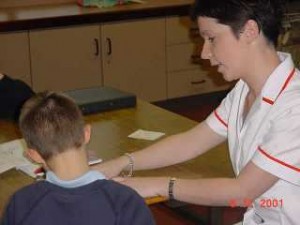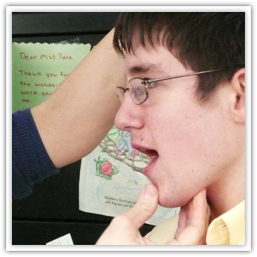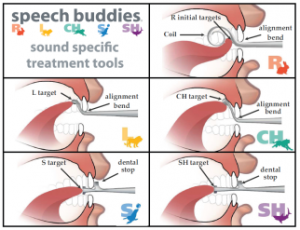Understanding Dentalized Lisps
A dentalized lisp is similar to a frontal or interdental lisp. With a frontal lisp, the child protrudes the tongue through the front teeth when pronouncing the “s” and “z” sounds. Children with a dentalized lisp push the tongue up against the front teeth, rather than through the front teeth. A dentalized lisp may arise during typical speech development. Some children with a dentalized lisp “grow out of it” by the time they are about four years old. However, it’s always best to bring your child to a speech-language pathologist (SLP), even if you think he might grow out of his articulation difficulty.
Identifying the Dentalized Lisp
An SLP will conduct an initial assessment to evaluate your child’s speech and language abilities. She will identify whether your child has a dentalized lisp, a different type of lisp, or a different speech disorder altogether. The speech therapist will analyze your child’s speech skills, fluency, and voice quality. She will also examine his oral structure and mobility.
Treating the Dentalized Lisp
To treat a dentalized lisp, your child’s speech therapist might begin with articulation therapy. Articulation therapy helps a child learn to discriminate between the proper articulation and the improper articulation of a sound. The speech therapist will demonstrate the phoneme by itself and guide the child through proper articulation. They will move to increasingly more complex sounds by pairing the “s” or “z” sounds with syllables, then with words, and then in short sentences.
Some speech therapists might also use auditory bombardment (AB) to treat a lisp. This type of speech therapy involves exposing the child to repetitive, intense demonstrations of the correct “s” and “z” sounds, along with other sounds for contrast. The term bombardment might sound as though your child will be undergoing an unpleasant treatment, but it simply refers to repetitive auditory stimulation.
Activities at Home
Along with your child’s speech therapy sessions, work with him on proper articulation at home to accelerate his progress. The speech therapist might provide you with lists of target words to practice. Make a game out of practicing the words to keep your child engaged in the learning process. For example, you can create a game similar to “I Spy” that involves you and your child naming objects around the home that contain the “s” or “z” sounds.
Another technique you might consider using is straw drinking. While some speech therapists discredit this technique, others find it immensely helpful. Provide your child with a drinking straw every time you serve him a beverage. Encourage him to think about the position of his tongue as he uses the straw. Straw drinking helps to pull the tongue back from its forward position against the teeth.
You could also use the Seal Speech Buddy to correct a dentalized lisp. This type of treatment for a lisp provides tactile feedback. The Speech Buddy is a simple device that provides a target in your child’s mouth so that he knows when his tongue is in the proper position.





